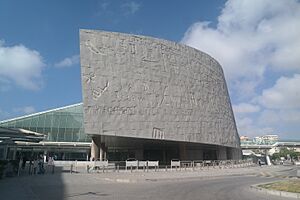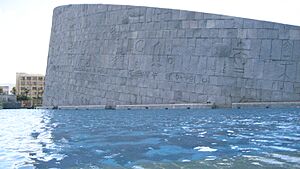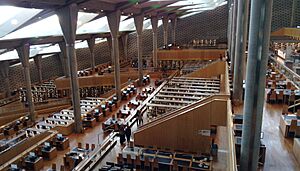Bibliotheca Alexandrina facts for kids
Quick facts for kids Bibliotheca Alexandrina |
|
|---|---|
| Aerial view of Bibliotheca Alexandrina in Alexandria | |
| Country | Egypt |
| Type | National library |
| Established | 16 October 2002 |
| Location | Alexandria |
| Coordinates | 31°12′32″N 29°54′33″E / 31.20889°N 29.90917°E |
| Access and use | |
| Members | 16,322 (2012) |
| Other information | |
| Director | Ahmed Abdullah Zayed |
The Bibliotheca Alexandrina is a huge library and cultural center. It is located on the coast of the Mediterranean Sea in Alexandria, Egypt. This modern library honors the famous Library of Alexandria. The ancient library was once one of the biggest in the world but was lost long ago.
Today's Bibliotheca Alexandrina holds books in Arabic, English, and French. The idea to build this new library started in 1974. Construction began in 1995 and cost about $220 million. The library officially opened on October 16, 2002.
In 2009, the library received a gift of 500,000 books. These books came from the National Library of France. This donation made the Bibliotheca Alexandrina the sixth-largest French-speaking library globally. The library can hold eight million books. Its main reading room is very large, covering 20,000 square meters.
The complex also has many other cool features. These include a conference center and special libraries. There are libraries for maps, multimedia, and for children. It also has four museums, art galleries, and permanent exhibitions. You can even find a planetarium and a lab to fix old manuscripts.
Contents
History of the Library

The idea to bring back the spirit of the ancient Library of Alexandria began in 1974. A group from Alexandria University chose a spot for the new library. This spot was near where the old library once stood. Former Egyptian President Hosni Mubarak strongly supported the project. UNESCO also partnered to help make it happen.
In 1988, UNESCO held a contest to pick the best design. A Norwegian architecture company called Snøhetta won the competition. They were chosen from 524 other designs. UNESCO also created a special group to oversee the project.
Money for the library was first promised at a meeting in 1990. Most of the $65 million came from countries in the Middle East and North Africa. Building started in 1995. After spending about $220 million, the library opened on October 16, 2002.
The Internet Archive also gave a big donation to the library. This included billions of web pages and thousands of hours of TV shows. They also donated many archival films and a book-scanning facility.
Amazing Features of the Library
The library has space for eight million books. Its main reading room is huge, spread across eleven levels. When it was built, this reading room was the biggest in the world. The library complex also includes a conference center. There are special libraries for maps, videos, and for people who are blind or have low vision. There are also sections just for young people and children.
The library complex has four museums and four art galleries. These galleries host temporary art shows. There are also 15 permanent exhibitions to explore. You can visit a planetarium and a lab that restores old manuscripts.
The main reading room has a 32-meter-high glass roof. It is tilted towards the sea, like a giant sundial. The walls are made of gray granite. They are carved with characters from 120 different writing systems.
Library Services
The main library can hold up to eight million books. It also offers a special service to print books on demand.
The Taha Hussein Library is designed for people who are blind or visually impaired. It uses special software to help them read books and journals. This library is named after Taha Hussein, a famous Egyptian writer who became blind as a child.
The library also has a special collection of books. These are books written by Nobel Prize winners in Literature since 1901. This Nobel Section was opened by Queen Silvia of Sweden and Queen Sonja of Norway in 2002.
Museums to Explore
Antiquities Museum
The Antiquities Museum opened in 2001. It is an archaeological museum located inside the library. It displays about 1,316 ancient artifacts. Some of these items were found underwater in the Mediterranean Sea. The museum provides descriptions in English, Arabic, and French.
Manuscript Museum
The Manuscript Museum lets visitors and researchers see rare manuscripts and old books. It opened in 2001 and has the world's largest collection of digital manuscripts. This museum works closely with the Manuscript Center.
Sadat Museum
This museum displays many personal items of former Egyptian President Anwar Sadat. You can see some of his military clothes and his Nobel Peace Prize medal. It also has his copy of the Qur'an, handwritten letters, and family photos. The museum even has a recording of his voice reading from the Qur'an.
Permanent Exhibitions
The Our Digital World exhibition shows off some of the library's digital projects. These include digital archives of past presidents. You can also see the Science Supercourse and the Encyclopedia of Life. Digital versions of famous books are also available.
The World of Shadi Abdel Salam exhibition features works by Egyptian film director Shadi Abdel Salam. His family donated these works. The Impressions of Alexandria exhibition has two parts. One shows Alexandria as seen by artists and travelers. The other part is a photo collection of Alexandria's diverse history.
The Culturama is a special hall with a 180-degree interactive screen. It is 10 meters wide and made of nine screens. Nine video projectors controlled by one computer create a panoramic view. This technology was developed by an Egyptian center and patented in 2007.
Digital Assets Repository
The Digital Assets Repository (DAR) is a system built by the library. It stores digital library collections. It also lets the public freely access the library's digitized items online.
How the Library is Managed
The Bibliotheca Alexandrina is managed by a Council of Patrons, a Board of Trustees, and a Director. This system was set up by a special presidential order in 2001. The first director was Ismail Serageldin, who served until May 2017. Moustafa El Feqy became the director after him.
The Board of Trustees has between fifteen and thirty members. Five of these members are always Egyptian government officials. These include the Minister of Higher Education, the Minister of Culture, and the Governor of Alexandria.
Library's Role in Recent Times
During the 2011 Egyptian revolution, the library was closed. But young people formed a circle around the building. They protected it from anyone who might try to damage or steal from it. Most of the library's visitors are students from nearby universities.
In 2011, the Bibliotheca Alexandrina held many discussions and events. These events focused on the 2011 Egyptian revolution. Other topics, like social work, were also discussed. All these events were free for everyone to attend.
See also
 In Spanish: Bibliotheca Alexandrina para niños
In Spanish: Bibliotheca Alexandrina para niños
- Bibliotheca Alexandrina's 100 Greatest Egyptian Films
- Planetarium Science Center





